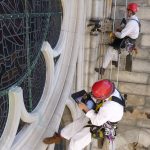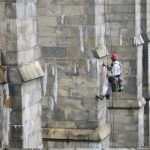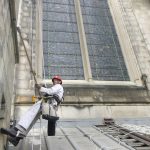A structure planned to “stand with practically no visible sign of change for 5,000 years.” That assessment, by Perry Borchers, was published in the Ohio State Engineer journal in 1940, soon after west façade of The Cathedral Church of Saint John the Divine was completed and just before the entire length of the Cathedral was consecrated in 1941.[1] In fact, much of the planned Cathedral structure had not yet been completed at that point, including the two towers on the west side, the north and south transepts and the spire above the crossing. However, eight days after the Cathedral was opened for the first time from the main portal on the west to the end of the apse on the east, and almost fifty years after construction of the Cathedral began in 1892, the United States entered World War II and work on the Cathedral came to a halt. Construction resumed in the 1970s, and in the 1980s about fifty feet of height was added to the south tower.
The Cathedral, situated in Morningside Heights in Manhattan on land acquired by the Episcopal Diocese in 1887, was originally designed by George Lewis Heins and Christopher Grant LaFarge in 1888. Construction of the apse began in 1892 and the large central dome, constructed by the Guastavino Company, was completed in 1909: the largest dome ever built by the firm. After Heins died, Ralph Adams Cram was hired in 1911 to replace LaFarge as the architect of the Cathedral. Construction of the nave, which Cram designed in a Gothic revival style, began in 1916 with the first finish stone on the south façade laid in 1925. Cram also designed the west façade of the Cathedral with its flanking towers and the gothic ornamentation for the original apse. The exterior cladding of the nave and towers is granite, with limestone used in the interior, the tracery of the stained glass windows at the nave and clerestory, and for trim and figurative carvings at the west facade.
Although the Cathedral is by anyone’s estimation a grand and magnificent structure, Borchers’ prediction that it remain unchanged for 5,000 years was a bit of hyperbole. Like any building, even one constructed by the finest craftsmen of the day using durable materials and proven engineering systems, the Cathedral is subject to the same deleterious effects of water, fire and earth movement as any other building. In fact, all of these forces have affected the structure significantly over the past 100 years.
A structure such as the Cathedral requires constant maintenance, upkeep and attention. Currently the Cathedral of St. John the Divine is undertaking a study of the entire structure. The design team is led by structural engineer Robert Silman Associates and includes Building Conservation Associates and Vertical Access. As part of the study, the team has been performing hands-on investigations of the exterior masonry, interior wall surfaces and ceiling; and evaluation of the condition of the exterior and interior materials and structure. The information gained from this study will be used to prioritize repair projects and plan for future work on the Cathedral, so that it may retain its magnificence for the next 100, or even 5,000, years.
[1] Perry Borchers, “The Cathedral of St. John the Divine, New York,” Ohio State Engineer, vol. 23, no. 6 (May, 1940, 8-10).



